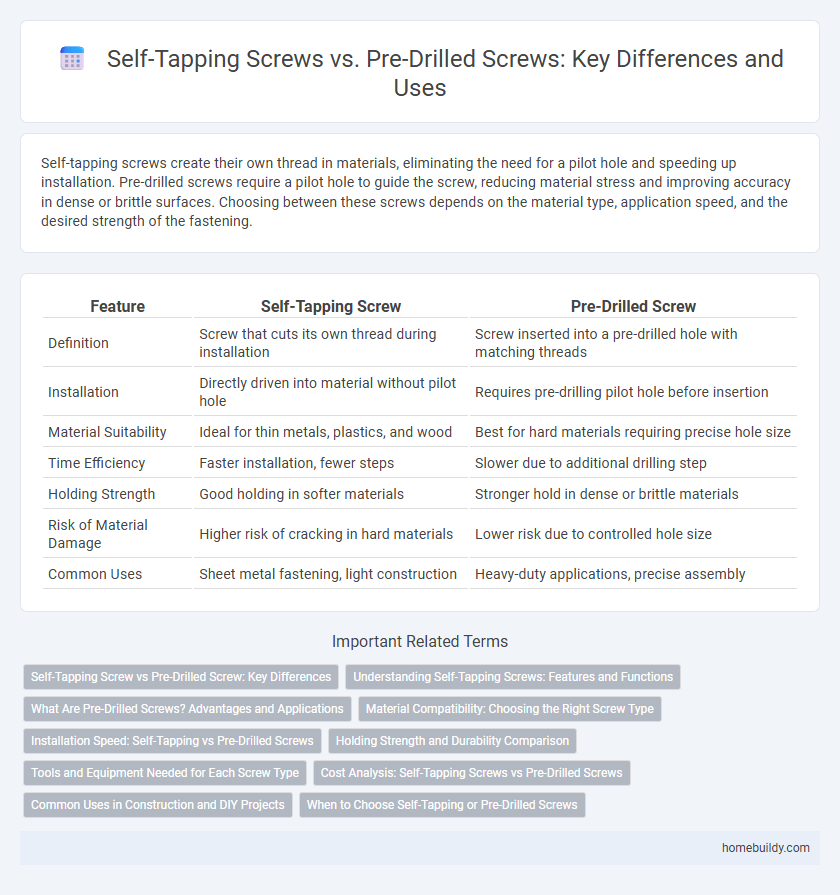Self-tapping screws create their own thread in materials, eliminating the need for a pilot hole and speeding up installation. Pre-drilled screws require a pilot hole to guide the screw, reducing material stress and improving accuracy in dense or brittle surfaces. Choosing between these screws depends on the material type, application speed, and the desired strength of the fastening.
Table of Comparison
| Feature | Self-Tapping Screw | Pre-Drilled Screw |
|---|---|---|
| Definition | Screw that cuts its own thread during installation | Screw inserted into a pre-drilled hole with matching threads |
| Installation | Directly driven into material without pilot hole | Requires pre-drilling pilot hole before insertion |
| Material Suitability | Ideal for thin metals, plastics, and wood | Best for hard materials requiring precise hole size |
| Time Efficiency | Faster installation, fewer steps | Slower due to additional drilling step |
| Holding Strength | Good holding in softer materials | Stronger hold in dense or brittle materials |
| Risk of Material Damage | Higher risk of cracking in hard materials | Lower risk due to controlled hole size |
| Common Uses | Sheet metal fastening, light construction | Heavy-duty applications, precise assembly |
Self-Tapping Screw vs Pre-Drilled Screw: Key Differences
Self-tapping screws create their own threads by cutting into the material, eliminating the need for a pre-drilled pilot hole, which speeds up installation in metal, wood, and plastic applications. In contrast, pre-drilled screws require a pilot hole to be drilled first, providing guided entry and reducing material stress, ideal for harder or more brittle substrates. The choice between self-tapping and pre-drilled screws depends on factors like material hardness, required holding strength, and installation efficiency.
Understanding Self-Tapping Screws: Features and Functions
Self-tapping screws feature a sharp, pointed tip and cutting threads designed to create their own hole as they are driven into materials like metal, plastic, or wood, eliminating the need for pre-drilling. These screws provide a secure grip and reduce assembly time by combining drilling and fastening into one step, making them ideal for quick and efficient construction tasks. Their ability to form mating threads enhances holding power and minimizes material damage compared to pre-drilled screws, which require a separate pilot hole for insertion.
What Are Pre-Drilled Screws? Advantages and Applications
Pre-drilled screws are fasteners designed to be driven into materials with a pre-made hole, reducing material stress and ensuring precise alignment. Their advantages include minimizing wood splitting, providing greater control in dense or brittle materials, and facilitating easier insertion in metal and plastic applications. Commonly used in cabinetry, metal frameworks, and fine woodworking, pre-drilled screws enhance structural integrity and finishing quality.
Material Compatibility: Choosing the Right Screw Type
Self-tapping screws are ideal for softer materials like plastic, wood, and thin metals, as their threaded design creates its own hole for a secure fit. Pre-drilled screws require a pilot hole, making them suitable for harder metals and dense materials where precision and minimal material stress are essential. Selecting the correct screw type based on material compatibility ensures optimal fastening strength and durability in construction or manufacturing applications.
Installation Speed: Self-Tapping vs Pre-Drilled Screws
Self-tapping screws significantly reduce installation time by eliminating the need for pre-drilling pilot holes, allowing for direct insertion into materials. Pre-drilled screws require an additional step to create a pilot hole, which increases overall labor and project duration. Choosing self-tapping screws enhances workflow efficiency, particularly in repetitive or large-scale fastening applications.
Holding Strength and Durability Comparison
Self-tapping screws create their own threads in materials, offering superior holding strength by tightly gripping the substrate without the need for pre-drilled holes. Pre-drilled screws rely on precisely sized pilot holes which can reduce material stress but often result in lower holding strength compared to self-tapping alternatives. In terms of durability, self-tapping screws maintain long-term stability in dynamic environments due to firm thread engagement, whereas pre-drilled screws may loosen over time if pilot holes enlarge or degrade.
Tools and Equipment Needed for Each Screw Type
Self-tapping screws require no pre-drilling, utilizing a power drill or screwdriver with compatible bits to create threads as they penetrate materials, reducing the need for additional tools. In contrast, pre-drilled screws demand a pilot hole created by a drill bit set, necessitating both a drill and appropriate drill bits before driving the screw with a screwdriver or impact driver. Using self-tapping screws streamlines fastening tasks by minimizing tool changes, whereas pre-drilled screws provide greater precision and reduce material stress at the expense of added preparation steps.
Cost Analysis: Self-Tapping Screws vs Pre-Drilled Screws
Self-tapping screws reduce labor costs by eliminating the need for pre-drilling, streamlining assembly and lowering overall project expenses. Pre-drilled screws incur extra time and tool costs due to the additional drilling step, increasing installation time and labor intensity. While self-tapping screws may have a higher unit price, their efficiency and reduced labor requirements often result in a more cost-effective solution in large-scale or repetitive fastening applications.
Common Uses in Construction and DIY Projects
Self-tapping screws are ideal for fastening materials like metal and plastic without the need for pilot holes, making them efficient for projects requiring quick assembly and strong hold. Pre-drilled screws are preferred when working with hardwoods or delicate materials, as pilot holes prevent splitting and ensure precise alignment. Both fastener types are widely used in construction and DIY projects, with self-tapping screws favored for metalwork and pre-drilled screws commonly used in woodworking applications.
When to Choose Self-Tapping or Pre-Drilled Screws
Choose self-tapping screws when working with softer materials like wood or thin metals, as they create their own threads and eliminate the need for pre-drilling. Pre-drilled screws are ideal for harder materials, such as dense hardwood or metal, where precision and preventing material splitting are crucial. Assessing material density and project requirements ensures optimal fastening strength and durability.
Self-Tapping Screw vs Pre-Drilled Screw Infographic

 homebuildy.com
homebuildy.com